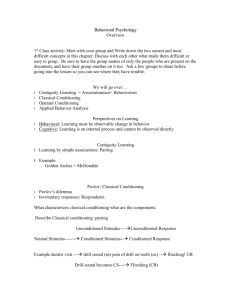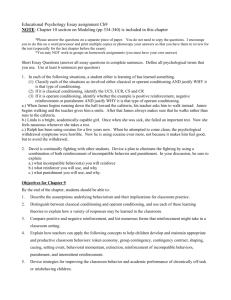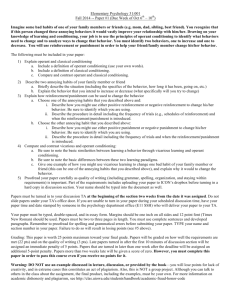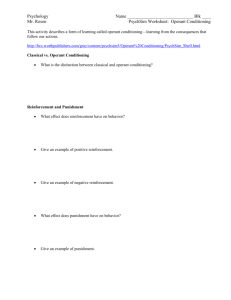Chapter 5 OC (operant conditioning) quiz practice
advertisement
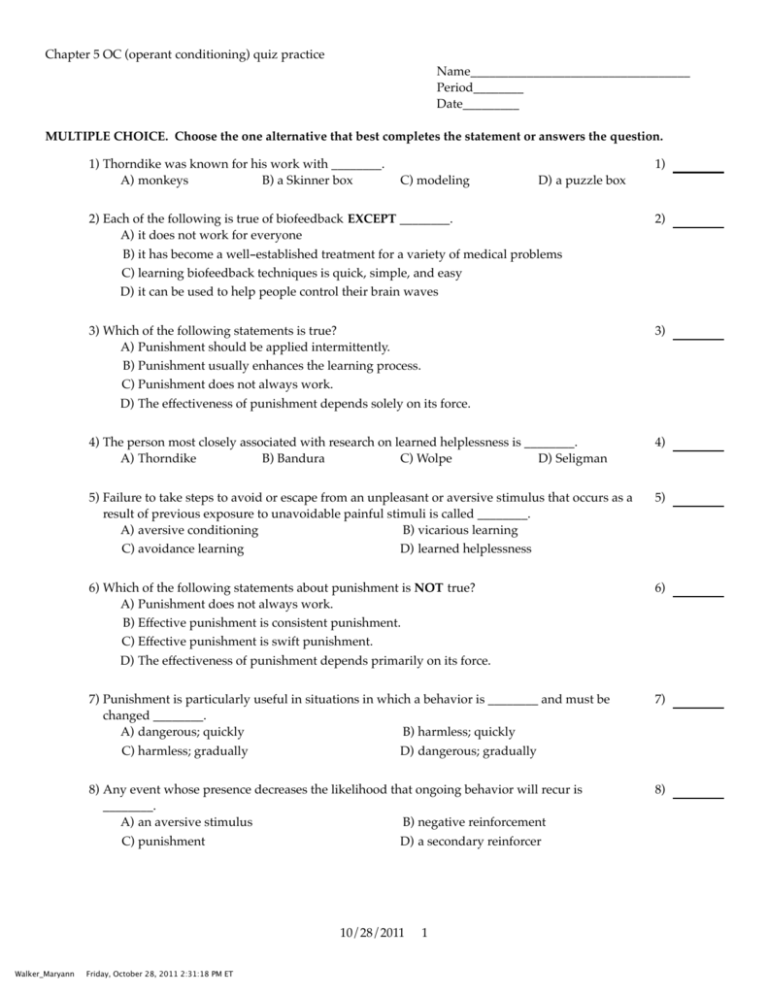
Chapter 5 OC (operant conditioning) quiz practice Name___________________________________ Period________ Date_________ MULTIPLE CHOICE. Choose the one alternative that best completes the statement or answers the question. 1) Thorndike was known for his work with ________. A) monkeys B) a Skinner box 1) C) modeling 2) Each of the following is true of biofeedback EXCEPT ________. A) it does not work for everyone B) it has become a well-established treatment for a variety of medical problems C) learning biofeedback techniques is quick, simple, and easy D) it can be used to help people control their brain waves 2) 3) Which of the following statements is true? A) Punishment should be applied intermittently. B) Punishment usually enhances the learning process. C) Punishment does not always work. D) The effectiveness of punishment depends solely on its force. 3) 4) The person most closely associated with research on learned helplessness is ________. A) Thorndike B) Bandura C) Wolpe D) Seligman 4) 5) Failure to take steps to avoid or escape from an unpleasant or aversive stimulus that occurs as a result of previous exposure to unavoidable painful stimuli is called ________. A) aversive conditioning B) vicarious learning C) avoidance learning D) learned helplessness 5) 6) Which of the following statements about punishment is NOT true? A) Punishment does not always work. B) Effective punishment is consistent punishment. C) Effective punishment is swift punishment. D) The effectiveness of punishment depends primarily on its force. 6) 7) Punishment is particularly useful in situations in which a behavior is ________ and must be changed ________. A) dangerous; quickly B) harmless; quickly C) harmless; gradually D) dangerous; gradually 7) 8) Any event whose presence decreases the likelihood that ongoing behavior will recur is ________. A) an aversive stimulus B) negative reinforcement C) punishment D) a secondary reinforcer 8) 10/28/2011 Walker_Maryann D) a puzzle box Friday, October 28, 2011 2:31:18 PM ET 1 9) Each of the following makes punishment more effective EXCEPT when it is ________. A) consistent B) arbitrary C) swift D) sufficient 10) When someone uses punishment to change a behavior, the probability of the behavior occurring is likely to ________. A) increase B) decrease C) generalize D) remain the same 10) 11) Which of the following statements is true? A) Positive reinforcement and negative reinforcement serve to increase the occurrence of a given behavior whereas punishment serves to decrease its occurrence. B) Positive reinforcement serves to increase the occurrence of a given behavior whereas negative reinforcement and punishment serve to decrease its occurrence. C) Positive reinforcement, negative reinforcement, and punishment all serve to increase the occurrence of a given behavior. D) Positive reinforcement, negative reinforcement, and punishment all serve to decrease the occurrence of a given behavior. 11) 12) The basic difference between punishment and reinforcement boils down to a difference between ________. A) conditioned and unconditioned stimuli B) presenting and removing stimuli C) decreasing and increasing response rates D) stimuli and responses 12) 13) ________ reinforcers result in the learning of new behaviors or the strengthening of existing ones. A) Negative, but not positive B) Neither positive nor negative C) Positive and negative D) Positive, but not negative 13) 14) Which of the following would probably be the most productive method to follow in order to teach a monkey a very complicated or difficult behavior pattern? A) Wait for the behavior to occur and then provide a large reward. B) Use discrimination training. C) Use higher-order conditioning. D) Reward simple behaviors that approximate the desired behavior, then require closer and closer approximation for further reward. 14) 15) A box used in operant conditioning of animals, which limits the available responses and thus increases the likelihood that the desired response will occur, is called a ________ box. A) response B) Watson C) trial D) Skinner 15) 16) There are ________ kinds of reinforcers. A) five B) two 16) C) four 2 Walker_Maryann 9) Friday, October 28, 2011 2:31:18 PM ET D) three 17) Operant conditioning operates on the principle that behaviors occur more often when they are ________. A) ignored B) punished C) reinforced D) modeled 17) 18) Instrumental conditioning is another term for ________. A) classical conditioning B) vicarious learning C) operant conditioning D) cognitive restructuring 18) 19) According to the law of effect, a behavior is MOST likely to be repeated when it is ________. A) followed by reinforcement B) paired with a neutral stimulus C) ignored D) preceded by reinforcement 19) 20) Kevin is a good student. He studies hard because when he does he gets the teacher's approval. His studying behavior was probably learned through ________. A) operant conditioning B) trial and error C) generalization D) classical conditioning 20) 21) Which of the following is NOT an example of operantly learned behavior? A) a dog blinking its eyes after a flash of light is presented B) a rat pressing a bar after avoiding a shock for this behavior C) a child doing her homework after she receives her teacher's approval for her behavior D) a rat pressing a bar after receiving food for this behavior 21) 22) An operant conditioning technique in which a learner gains control over some biological response is ________. A) social learning B) biofeedback C) preparedness D) contingency training 22) 23) College students faced with unsolvable problems eventually give up and make only half hearted attempts to solve new problems, even when the new problems can be solved easily. This behavior is probably due to ________. A) contingency blocking B) latent learning C) response generalization D) learned helplessness 23) 24) Each of the following is true of learned helplessness EXCEPT ________. A) once established it generalizes to new situations B) it decreases motivation to try different responses that might bring relief from an unpleasant situation C) success in solving new problems is quite effective in eliminating it D) it can be found in both people and animals 24) 25) Superstitious behaviors are MOST commonly learned through ________. A) vicarious learning B) operant conditioning C) subliminal learning D) classical conditioning 25) 3 Walker_Maryann Friday, October 28, 2011 2:31:18 PM ET 26) Punishment is a(n) ________ controller of behavior. A) powerful B) ineffective D) weak 27) Presenting an aversive stimulus to eliminate undesired behavior is an example of ________. A) negative reinforcement B) positive reinforcement C) shaping D) punishment 27) 28) Skinner found that if he randomly presented rewards to pigeons in a Skinner box, the pigeons ________. A) developed a series of superstitious behaviors B) developed a series of trial and error behaviors in an attempt to get the reward C) refused to eat the food D) ceased all movement until the food pellets were randomly presented for a second time 28) 29) A child is praised for using his fork instead of his fingers to eat some spaghetti. This is an example of ________ reinforcement. A) higher-order B) secondary C) extrinsic D) positive 29) 30) In negative reinforcement, the ________ of a(n) ________ stimulus follows a response and changes the likelihood of that response reoccurring. A) onset; pleasant B) termination; pleasant C) termination; aversive D) onset; aversive 30) 31) When someone uses negative reinforcement to change a behavior, the behavior is likely to ________. A) occur more frequently B) occur at the same rate C) occur less frequently D) completely stop 31) 32) A child is scolded for using his fingers instead of his fork to eat some spaghetti. The scolding stops when he picks up his fork. Stopping the scolding is an example of ________ reinforcement. A) tertiary B) positive C) secondary D) negative 32) 33) A reinforcer that adds something rewarding to a situation is a(n) ________ reinforcer. A) additive B) positive C) secondary D) primary 33) 34) Changing behavior through the reinforcement of successive approximations of a desired response is called ________. A) modeling B) classical conditioning C) shaping D) negative reinforcement 34) 35) The two researchers most closely associated with operant conditioning are ________. A) Bandura and Ellis B) Freud and Perls C) Pavlov and Watson D) Skinner and Thorndike 35) 4 Walker_Maryann 26) C) sporadic Friday, October 28, 2011 2:31:18 PM ET 36) Any stimulus that follows a behavior and increases the likelihood that the behavior will be repeated is called a ________. A) reinforcer B) situational artifact C) higher-order conditioner D) cue 36) 37) Spontaneous, voluntary behaviors that you engage in by choice are called ________ behaviors. A) operant B) latent C) vicarious D) manifest 37) 38) The idea that a behavior will increase or decrease based on the consequences that follow that behavior is crucial to ________. A) insight learning B) operant conditioning C) vicarious learning D) classical conditioning 38) 39) An example of a behavior that is learned through operant conditioning is ________. A) cleaning up your room to get your parents' approval B) pulling one's hand away from a flame C) sneezing in response to dust D) blinking in response to a flash of light 39) 40) A problem with avoidance training is that ________. A) its effects tend to last only for a short time B) it tends to take effect when it is too late to make a difference in avoiding the problem situation C) the learned behavior sometimes persists when it is no longer effective or necessary D) it tends to produce latent learning 40) 41) Research on the use of rewards to facilitate learning indicates that ________. A) linking rewards to learning reduces creativity but not motivation B) even when used properly, linking rewards to learning actually reduces natural motivation and creativity C) linking rewards to learning does not compromise either motivation or creativity D) linking rewards to learning reduces motivation but not creativity 41) 42) A reinforcer that removes something unpleasant from a situation is a(n) ________ reinforcer. A) negative B) primary C) secondary D) positive 42) 43) Nagging someone to do something until they do it is an example of ________. A) punishment B) positive reinforcement C) aversive conditioning D) negative reinforcement 43) 44) Positive reinforcement ________ the likelihood that the behavior preceding it will happen again while negative reinforcement ________ the likelihood that the preceding behavior will happen again. A) decreases; decreases B) increases; increases C) increases; decreases D) decreases; increases 44) 5 Walker_Maryann Friday, October 28, 2011 2:31:18 PM ET 45) Any event whose reduction or termination increases the likelihood that an ongoing behavior will recur is a(n) ________. A) negative reinforcer B) positive reinforcer C) antecedent D) punisher 45) 46) Any stimulus that follows a behavior and decreases the likelihood that the behavior will be repeated is called a(n) ________. A) negative reinforcer B) punisher C) antecedent D) aversive stimulus 46) 47) Emitted, voluntary behavior is BEST modified by ________. A) trial and error B) classical conditioning C) operant conditioning D) aversive conditioning 47) TRUE/FALSE. Write 'T' if the statement is true and 'F' if the statement is false. 48) The step-by-step reinforcement of partial responses is called shaping. 48) 49) Punishment alone works better than punishment combined with reinforcement of the desired behavior. 49) 50) Punishment is the same as negative reinforcement. 50) 51) The law of effect is the same thing as classical conditioning. 51) 52) A reinforcer can be anything that, when presented after a response, increases the likelihood of the response being repeated. 52) 53) A crucial element of classical conditioning is emitted behavior. 53) 54) Negative reinforcement results in the extinction of previously learned behaviors. 54) 6 Walker_Maryann Friday, October 28, 2011 2:31:18 PM ET Answer Key Testname: CH 5 OC QUIZ PRACTICE 1) D 2) C 3) C 4) D 5) D 6) D 7) A 8) C 9) B 10) B 11) A 12) C 13) C 14) D 15) D 16) B 17) C 18) C 19) A 20) A 21) A 22) B 23) D 24) C 25) B 26) A 27) D 28) A 29) D 30) C 31) A 32) D 33) B 34) C 35) D 36) A 37) A 38) B 39) A 40) C 41) C 42) A 43) D 44) B 45) A 46) B 47) C 48) TRUE 49) FALSE 10/28/2011 Walker_Maryann Friday, October 28, 2011 2:31:18 PM ET 7 Answer Key Testname: CH 5 OC QUIZ PRACTICE 50) FALSE 51) FALSE 52) TRUE 53) FALSE 54) FALSE 8 Walker_Maryann Friday, October 28, 2011 2:31:18 PM ET



